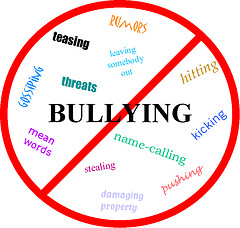Every parent hopes their child will never have to deal with the pain and trauma that bullying creates. Unfortunately, with another school year beginning in a few weeks, parents must face the reality that many children are still bullied in school environments, and it’s an issue that won’t stop without adult intervention.
Bullying comes in different forms: it can be physical or verbal, face-to-face or through social media. Whatever forms it comes in, bullying negatively affects a child’s behavior, emotional and psychological well-being. In severe cases, bullying has lead children to hurt themselves or someone else.
According to the 2010-2011 School Crime Supplement, 28 percent of American children in 6th grade to 12th grade are affected by bullying. This means that almost 1 in 3 students experience some type of bullying. Many instances of bullying are not reported or addressed.
Often a victim, or a target, of bullying feels too ashamed to seek help. They fear the repercussions of “tattling,” believing the bullying will get worse if they tell. Because of this, some targets will not tell anyone or seek help.
As a parent there are certain signs to look for that might indicate your child is a target of bullying:
- Avoiding school or school activities (like dances or school sports)
- Disruptive classroom behavior
- Low academic performance
- Isolation (if your child has few or no friends)
- Loss of personal items or destruction of personal items
- Bruising or other injuries
- Loss of appetite
- Mood swings
- Low self-esteem
- Depression
- Anxiety (e.g., complains of headache or stomach ache)
How is a target chosen? Bullies will often target children who:
- Are anxious, shy or insecure
- Are noticeably different than other children (this could be due to clothing, race, sexual orientation, high or low grades, physical disabilities, appearance etc.)
- Have poor social skills
- Get upset or emotional easily
- Respond quickly to teasing
But not every child who has these traits will be bullied. According to an article on bullying written by therapists, Anjali Pinjala and Jeremy Pierce, there are certain circumstances that seem to encourage bullying behaviors:
1) The bully must see the target as weak, and the target must perceive themselves as weaker than the bully;
2) The bully must believe there will be little or no consequences for the bullying behavior; and
3) The bully has learned this behavior as a means for getting certain needs met (e.g., attention or way of expressing anger).
What Can Schools Do?
Once bullying is identified it should be brought to the attention of the school administration. The bully should be identified and school administration should send a message making it clear that bullying will not be tolerated.
The best way to deal with bullying is both prevention and intervention. Below are some suggestions for how schools can handle bullying:
- Maintain adult supervision throughout the school but especially in areas such as the school cafeteria, playground, or gymnasium.
- Establish policies and rules that include a clear definition of bullying and consequences for bullying behaviors.
- Include anti-bullying messages and information in school-related materials (e.g., student handbook, website, newsletters).
It’s important to remember that bullying is a learned behavior, which means that if a child is a bully at school, it is probably because they witness or experience bullying at home and have learned bullying as a strategy to get certain needs met. Counseling can help children who bully and their families to take steps towards healthier behavior. If nothing changes, a bully might grow up without the ability to co-operate in a team setting, and will continue to be a bully in their adult life. They also risk passing the behavior down to their own children.
What Can Parents Do?
- Help to reduce self-blame by communicating openly with your child about bullying. Assure them it’s nothing to be ashamed of, and that they deserve to be treated with respect by their peers.
- Communicate with your child’s teachers and the school principal. Ask about the school’s anti-bullying policies and volunteer to help the school work towards creating a safer environment for its students.
- Raise awareness within your community. Encourage others parents to get involved in anti-bullying projects that work towards a healthy and safe community for children.
- Check with your child and child’s teachers periodically to ensure the bullying has stopped.
- If the bullying continues and you’re worried your child might be seriously injured or traumatized, considering contacting the police.
- Remember that you are constantly a role model for your child. Children look to their parents for guidance and are influenced by their attitudes. When your child is around, always consider how your words and actions might influence them, and how it might lead them to interact with their peers.
Treating Children Who are Bullied
Family therapists are qualified to work with parents and children to rebuild self-esteem and reduce self-blame in the child, while taking steps to prevent bullying from occurring again. The target needs to realize that they have a right to feel safe at school. A therapist will educate the target about bullying, understanding social behaviors and body language and building a sense of confidence and control.
Every child has a right to a safe, happy and healthy school environment. If you have any questions about bullying consider reaching out to us at Family & Child Development.

